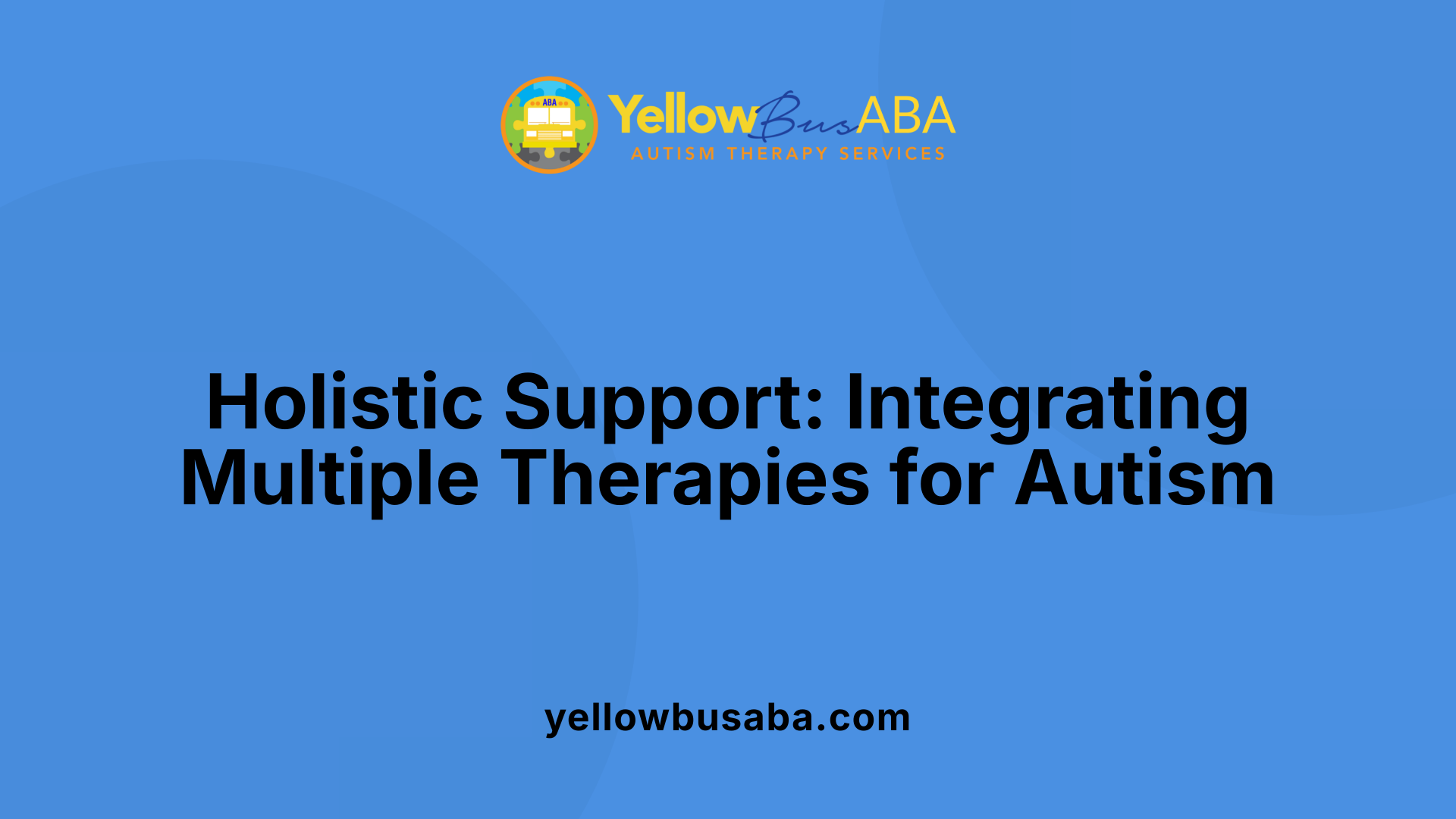Autism Therapy Techniques That Work Beyond the Clinic
October 30, 2025
Extending Autism Support: Effective Therapies Outside Traditional Settings

Redefining Autism Therapy Beyond the Clinic Walls
As understanding of autism spectrum disorder (ASD) advances, therapeutic approaches have evolved to extend beyond clinical settings into homes and digital environments. This article explores how evidence-based techniques like Applied Behavior Analysis (ABA) integrate with speech, occupational, and psychotherapy, enhanced by technological innovations and family involvement. We examine how these strategies empower individuals with autism to develop vital skills in natural and supportive environments, fostering greater independence and quality of life.
Applied Behavior Analysis (ABA): Foundations and Providers
What is Applied Behavior Analysis (ABA) therapy?
Applied Behavior Analysis (ABA) therapy is a scientific and evidence-based approach aimed at understanding and modifying behavior. It operates on learning principles, primarily using positive reinforcement to encourage helpful behaviors such as communication, social interaction, and academic skills, especially in individuals with autism spectrum disorder (ASD).
ABA therapy involves individualized assessment and goal setting to tailor interventions for each person's unique needs. Techniques used include discrete trial training, natural environment teaching, and pivotal response treatment. Research supports ABA’s effectiveness across multiple developmental domains, including improvements in IQ, language, and social skills.
Who provides ABA therapy services?
ABA services are delivered by a team of trained professionals, most notably Board Certified Behavior Analysts (BCBAs), Board Certified Assistant Behavior Analysts (BCaBAs), and Registered Behavior Technicians (RBTs). BCBAs typically lead the process by designing assessments, creating personalized treatment plans, and overseeing implementation. RBTs and other therapists carry out therapy sessions directly.
These providers work in various settings such as homes, schools, and clinics. In-home ABA therapy is popular because it integrates skill development into daily routines, promotes generalization of behaviors, involves families directly, and creates a safe learning environment.
How is ABA therapy individualized?
Individualized assessment is the foundation of ABA therapy. The therapy begins with collecting data on the individual’s behaviors and needs. Based on this, tailored goals are set that cover communication, social skills, daily living skills, and more.
Therapists regularly monitor progress and adjust goals and methods accordingly, ensuring that interventions remain effective and relevant. Family members are often trained to apply ABA techniques consistently to support skill maintenance and generalization across different settings.
In summary, ABA therapy is a personalized, evidence-based approach delivered by qualified professionals who collaborate closely with families to optimize outcomes for individuals with ASD.
Core ABA Techniques That Promote Skill Development

What are some common techniques used in ABA therapy?
Applied Behavior Analysis (ABA) therapy employs a variety of techniques designed to encourage desirable behaviors and teach new skills effectively. One foundational method is positive reinforcement, which involves rewarding desired behaviors immediately to increase the likelihood they will be repeated.
Another fundamental approach is prompting and fading. Therapists provide prompts to guide a learner initially and then gradually reduce assistance, which helps the individual gain independence in the skill.
Discrete Trial Training (DTT) is a structured teaching technique where skills are broken down into small, manageable components. Each trial includes clear instructions, a response, and a consequence such as reinforcement or correction, allowing for focused repetition.
In contrast, Natural Environment Teaching (NET) encourages learning in everyday settings and activities. This method helps children apply skills spontaneously and generalize behaviors beyond structured sessions.
Behavior chaining breaks complex tasks into small sequential steps, teaching each step systematically until the entire task can be performed independently. Visual modeling, using pictures or videos, supports learners by providing clear examples of target behaviors.
Finally, extinction is used to reduce undesirable behaviors by withholding reinforcement previously maintaining them, helping to decrease their frequency over time.
Together, these techniques are adapted to each individual's needs, fostering skill acquisition, independence, and meaningful improvements in behavior.
Multidisciplinary Therapy Integration for Holistic Support

Combining ABA with Speech Therapy
Applied Behavior Analysis (ABA) forms a foundational approach in autism treatment due to its strong evidence base. When combined with speech therapy, ABA promotes significant improvements in communication skills. Speech therapy integrated with ABA targets language development by teaching communication fundamentals systematically. This includes working on articulation, comprehension, and verbal expression, thereby enhancing social interaction capabilities.
Role of Occupational Therapy Alongside ABA
Occupational therapy complements ABA by concentrating on functional self-care abilities, fine and gross motor skills, and sensory processing. This combined approach helps autistic individuals learn and generalize important daily living skills within natural settings. Occupational therapy supports ABA's behavioral strategies by addressing physical and sensory challenges, enriching overall progress in adaptive functioning.
Psychotherapy Integration to Address Emotional and Behavioral Needs
Incorporating psychotherapy with ABA further expands the scope of treatment by addressing emotional regulation and behavioral health. Psychotherapy supports managing anxiety, fostering emotion regulation, and promoting meaningful social interactions. Through this multidisciplinary blend, treatment not only targets skill acquisition but also underlying emotional well-being, thereby benefiting the comprehensive development of individuals with autism.
Technological Enhancements Amplifying ABA Therapy Effects

Mobile Applications in ABA
Mobile applications have become a dynamic tool in ABA therapy by utilizing an autistic individual’s natural interest in digital devices. These apps provide personalized exercises that help reinforce learning through consistent practice and immediate feedback. This interactive approach supports the development of communication, cognitive, and social skills in a user-friendly format that can be accessed anytime, boosting engagement and motivation.
Virtual Reality for Social and Self-Care Skill Practice
Virtual reality (VR) systems offer a safe, controlled setting where individuals with autism can practice social interactions and self-care routines. By simulating real-world environments, VR allows gradual exposure to challenging situations. This immersive experience helps users build and generalize skills, such as conversation, navigating social cues, and managing daily tasks, without the pressure of actual social settings.
Artificial Intelligence for Data-Driven Treatment Adjustments
Artificial intelligence (AI) enhances ABA by improving the collection and analysis of behavioral data. AI tools can detect patterns in a child’s progress, identify areas needing change, and guide clinicians in fine-tuning therapy plans. This data-driven approach results in more personalized treatment, better tracking of developmental outcomes, and timely modifications that optimize the effectiveness of ABA interventions.
Home-Based ABA Therapy: Natural Environment Advantages
What are the benefits of in-home therapy sessions?
In-home ABA therapy offers a unique advantage by integrating treatment into the child's natural environment. This setting fosters comfort and safety, which can reduce undesirable behaviors and enhance learning. Being in familiar surroundings helps the child generalize skills more effectively across various contexts.
How is ABA therapy integrated into daily routines at home?
Therapists design ABA programs that fit seamlessly into everyday family activities. This integration supports natural learning opportunities, allowing children to practice social, verbal, and self-help skills during routine tasks. Regular sessions can include family interactions and daily living skills like toilet training, which tend to be more successful when taught in natural settings.
What constitutes an effective home therapy environment?
Creating an effective therapy space at home involves establishing dedicated areas free from distractions, consistent routines, and visual schedules to guide the child's activities. These elements encourage focus and predictability, which are essential for skill acquisition and behavior management.
Why is parental involvement and training important in home-based ABA?
Parents and caregivers actively participate and reinforce therapy goals during sessions, which boosts treatment effectiveness. Training equips them with techniques to support skill generalization outside of formal sessions and maintain progress. Research shows that parent involvement enhances verbal communication, social interaction, and behavior maintenance.
Additional benefits
Home-based ABA therapy fosters collaboration among providers and allows immediate feedback and plan adjustments. It is flexible, tailored to each family's circumstances, and can complement or replace facility-based care. Telehealth options further expand accessibility, especially in underserved areas.
Effectiveness of ABA Therapy Across Developmental Domains
How effective is ABA therapy for individuals with autism?
ABA therapy is a well-established, evidence-based intervention recognized for its significant impact in treating autism spectrum disorder (ASD). This approach applies learning principles such as positive reinforcement and individualized behavior strategies to support development in various areas.
Overall evidence supporting ABA effectiveness
Multiple meta-analytic studies consistently confirm ABA therapy's effectiveness across a range of developmental domains. These studies measure changes using standardized tools like IQ tests and adaptive behavior scales, showing meaningful improvements after intervention.
Improvements in intellectual abilities and IQ
ABA has demonstrated a strong effect in enhancing intellectual abilities, with one meta-analysis reporting an effect size (g) of 0.740 in children with ASD. These gains highlight ABA's role in developing cognitive skills vital for learning and problem solving.
Language and communication skill gains
ABA interventions show moderate to high effectiveness in language development. Specifically, receptive language (understanding) improvements come with an effect size of 0.597, while expressive language (speaking) exhibits an even greater improvement at 0.742. Structured teaching and reinforcement techniques are core to these advancements.
Adaptive behavior and socialization enhancement
Adaptive behavior, including communication and social skills, also improves moderately through ABA (effect sizes around g=0.422 for overall adaptive behavior and g=0.650 for communication). These outcomes reflect ABA's ability to strengthen real-world functioning and relationships.
Daily living skills outcomes and contributing factors
While ABA has low to moderate effectiveness for daily living skills (effect size g=0.138), contributing factors such as participant age and program focus on language and cognition likely influence this result. Younger children may require more targeted interventions to see greater gains in self-care and independent functioning.
In summary, ABA therapy offers robust evidence-based benefits, particularly in intellectual, language, and social domains for individuals with ASD. Ongoing research and tailored, intensive programs optimize these outcomes to enhance quality of life and functional independence.
Parental and Caregiver Roles: Empowering Consistency and Generalization

Why Is Family Involvement Crucial in ABA Therapy?
Family engagement is fundamental to the success of Applied Behavior Analysis (ABA) interventions. Parents and caregivers play an essential role in reinforcing skills learned during therapy sessions by applying ABA techniques consistently throughout daily routines and various environments. This involvement helps ensure that the newly acquired behaviors generalize beyond the clinical or therapy setting into real-life situations, increasing the durability and relevance of those skills.
How Are Parents Trained to Use ABA Strategies?
Therapists provide thorough training to parents and caregivers, enabling them to understand and implement ABA methods effectively. Training sessions focus on teaching behavior reinforcement methods, prompting strategies, and how to track progress. By equipping families with practical skills, parent training empowers them to become active collaborators, supporting their child's development and promoting greater independence.
How Does Caregiver Participation Enhance Behavior Maintenance?
Active caregiver involvement supports consistent application of therapeutic approaches, which is critical for maintaining and generalizing learned behaviors. When parents integrate ABA techniques into everyday interactions, it reduces the risk of skill regression and fosters continuous learning. This consistent practice across settings such as home, school, and community ensures that children with autism sustain their progress and adapt skills to diverse scenarios.
What Is the Impact on Verbalization and Social Interaction?
Evidence shows that when parents are involved in ABA intervention, children show notable improvements in verbalization, spontaneous speech, and social engagement. Caregiver participation encourages more naturalistic communication opportunities and reinforcement, which accelerates language development and increases social motivation. This collaborative approach enhances both the quantity and quality of social interactions, crucial for building meaningful relationships and communication abilities.
Together, these elements highlight the indispensable role families have in ABA therapy — helping transform structured clinical gains into lifelong, functional skills for individuals with autism.
Telehealth: Expanding Access and Flexibility of Autism Therapy

What is telehealth ABA therapy and how is it delivered?
Telehealth ABA therapy utilizes videoconferencing technology to provide Applied Behavior Analysis interventions remotely. This approach enables Board Certified Behavior Analysts (BCBAs) and therapists to connect with children and their families without the need for in-person visits, facilitating therapy sessions in the comfort and familiarity of the home or any location with internet access.
How does telehealth benefit rural or hesitant families?
Telehealth significantly expands access for families living in rural or underserved areas where clinic-based ABA services may not be readily available. It also supports families who may hesitate to attend in-person sessions due to various constraints or health concerns, providing a convenient and non-threatening alternative that reduces travel time and logistical barriers.
What are the cost-effectiveness and provider availability advantages?
Providing ABA therapy through telehealth reduces overhead costs associated with clinics and transportation, making therapy more affordable for many families. Additionally, telehealth increases the pool of available ABA providers by overcoming geographical limits, thereby lowering wait times and improving access to specialists.
Can telehealth ABA replace or complement traditional in-person care?
Telehealth ABA services can either complement traditional facility or home-based therapies by offering flexible scheduling and ongoing support or serve as the primary mode of intervention when in-person options are limited. The modality promotes collaboration among providers and families through virtual meetings, enabling timely adjustments to individual treatment plans.
In summary, telehealth ABA therapy provides a flexible, accessible, and effective option for delivering autism treatment, especially advantageous for families facing geographic or other barriers to conventional care.
Empowering Autism Therapy Beyond Traditional Settings
Innovations in therapy delivery have transformed how autism support is provided, moving significant components of care beyond clinical walls. ABA therapy, enriched with multidisciplinary collaboration, technological tools, and family engagement, shows powerful effectiveness in naturalistic environments like the home. By fostering skill generalization, reducing behaviors, and improving adaptive functioning, these approaches offer greater accessibility and individualized care. As telehealth and digital resources expand, the future promises broader reach and flexibility, empowering individuals with autism and their families to thrive in everyday life contexts.
References
- Applied Behavior Analysis: Key Points to Improve Autism ...
- The effectiveness of applied behavior analytic interventions ...
- 6 Home-Based Autism Therapy Options Parents Can ...
- Home-Based Applied Behavior Analysis Therapy
- Applied Behavior Analysis (ABA)
- Behavioral Health Treatment | Children with Autism Spectrum ...
- Who can provide ABA therapy?
- Applied Behavior Analysis (ABA)
- Statement on Use of Applied Behavior Analysis (ABA) for ...






